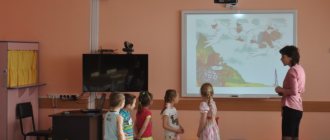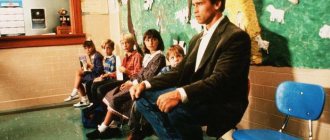Child from two to three years old
Gradually, as the child develops, there is a transition of action from joint to independent . The adult retains control and assessment of the actions performed by the child; they constitute the content of communication between the child and the adult.
During this period, it is very important for the child that his mother shares his delight in the fact that splashes in the bathroom fly in all directions. Or hands stained with paint leave incredibly beautiful marks on the wallpaper. That is, actions with objects are interesting not only in themselves, but also as a way to attract the attention of an adult.
At this age, a child can already draw parallels between himself and a fairy-tale hero, correct the hero’s actions, and make his own additions to the development of the storyline. Therefore, a fairy tale, composed by joint efforts, helps maintain emotional contact between mother and child, performs developmental, educational, training functions, and also solves preventive and preparatory tasks. With the help of such a fairy tale, a child can be prepared for some unpleasant but inevitable procedure, for example, a mother’s business trip or a visit to the dentist.
In the process of preparing to write a fairy tale, several stages can be distinguished.
Involving the baby in the fairy tale is achieved by the fact that at key moments in the story, the mother can ask the child questions that the hero needs to answer, or perform appropriate actions, as shown in the story below.
A fairy tale for visiting a clinic might sound, for example, like this:
Once upon a time there lived in a small house in the forest a little bunny, a little bunny, a little bunny, and a little bunny. Father hare worked a lot, so he could not spend as much time with the bunny as he wanted, and was rarely at home. The bunny mother and the bunny son often did their bunny business together: they played happily, read interesting books, went to the store and took long walks in the forest.
One evening the mother bunny said to her little bunny son:
“Tomorrow morning you and I have an important task ahead of us.”
- We need to go to the doctor, show him your paw and prick your finger.
Here you can try to involve your child in the fairy tale: “What do you think the little bunny son answered to the mother bunny?” or “what do you think, why do all the bunnies get vaccinated?” It is necessary to create an awareness of the usefulness of vaccination, despite the unpleasant sensations during the procedure itself.
— Vaccinations are given to all little bunnies, and sometimes even to adult hares, so that they grow up strong and healthy and get less sick.
Mom saw that the bunny was very scared, sat him on her lap, hugged him and said:
“Are you afraid that pricking your finger will hurt?”
“You know, it will hurt a little, but not for long.” Then the doctor will take out various interesting tubes and apply them to your finger. Would you be interested in looking at different tubes? Or even talk to the doctor about them, she probably knows a lot about them.
“I have a proposal for you: come on, when the doctor pricks your finger, I’ll hug you tightly and command: “Close your eyes!” And after that you will say loudly: “Oh!” And you will immediately open your eyes to look at the tubes. Agreed?
(At this stage, you can also involve the child in your fairy tale: “What did the little bunny son answer to the mother bunny?”)
And then my mother suggested:
An important educational element is communication with the child before going to bed. This communication can also be accompanied by a fairy tale.
One day Bunny and his mother went on a picnic. They prepared sandwiches together, made tea, Bunny himself washed two apples and put them in his backpack. Mom looked at Bunny, who had already taken his backpack and put on his cap, and asked:
- Bunny, are you ready? Shall we go out?
The bunny nodded intently.
The path ahead was not close: Bunny and her mother were going to go to a sheep farm, watch the lambs and lambs. The travelers crossed a large clearing, climbed a hillock, went down to a cheerful forest stream, and crossed it along a log. Finally, the fence of a sheep pen appeared in the distance.
The bunny felt a little tired and hungry. Bunny's mother was already spreading a blanket under their favorite slender birch tree. The bunny plopped down on him with pleasure:
- Wow, how tired my paws are! Sit down, mom, the sheep are already starting to jump!
The mother smiled affectionately at her baby, unpacked her backpack and sat down next to him.
Mom gently stroked the Bunny on the head and nodded:
— One sheep jumped over the fence. the second sheep jumped over the fence. the third sheep jumped over the fence. The fifty-eighth sheep jumped over the fence.
The bunny dozed off unnoticed. Mom covered him with a blanket:
Source
Where to begin
You can compose fairy tales casually, on the go. After all, when your hands are busy with housework, your head is free for creativity. The child will be happy to participate in the development of a fairy tale plot and in the game, quietly expand his vocabulary, consolidate the grammatical structure of speech, and, most importantly, practice the art of storytelling (oral monologue speech).
You can write fairy tales about anything, even about vegetables and household utensils, but first practice on “simple” material. There are different “recipes” for organizing such creative training. How you use them depends on the age of the child. A child over 4 years old can compose together with an adult, and a 5-6 year old can already compose quite freely on his own, and the adult’s task is to give impetus to composing. Much depends on his and your creative capabilities, the conditions in which you will start writing (whether it will be in a specially allotted time or you will have to write while doing other things, or maybe while on the road).
Child from six months to one year
The child grows and develops, he acquires new skills and abilities. Thus, grasping, direction towards an object, stimulates the occurrence of sitting. When a child sits down, other objects open up in front of him. There are also those that cannot be touched. This reveals the law of the child’s advance acquaintance with the world. The child reaches out to an object that is attractive, but it can only be obtained with the help of an adult.
Taking into account the changing perception and needs of the child, the fairy tale that the mother tells changes. Here a plot may already appear, unfolding around the functioning of the object . The child can act as an active participant in the fairy tale, its hero. The fairy tale should be short: ten to twelve short sentences, using simple, specific words that the child can understand. By listening to a fairy tale, a child expands his vocabulary, gains knowledge about a subject that interests him, and is also enriched with a wide range of general knowledge, for example, about etiquette or the culture of communication. The function of preserving and maintaining emotional contact with a fairy tale is also important for a child of this age. Telling a fairy tale requires some artistry from the storyteller, the ability to speak on behalf of various characters.
For example, a child shows great interest in an alarm clock, the introduction to which can be played out in the form of a fairy tale.
The baby came to visit the alarm clock: stomp, stomp, stomp!
- What else can you do?
- Yes I want to! (If the sound of the alarm clock is not too sharp and loud, then you can listen to its sound with your child)
- And I also show the time and say: it’s time for lunch! (the last phrase becomes an exit from the fairy tale and the child switches to another activity).
re-enactment
Invite your child to “revive” the fairy tale: come up with costumes, develop the behavior of the characters in accordance with their personalities, think through the facial expressions, gestures, and intonation of each character. The purpose of such a task is to activate a creative attitude towards words. Creative comprehension should manifest itself in the ability to transform a verbal fairy-tale image into a dramatic one.
Collective creativity is also assumed here. Not only children, but also toys and dolls can play roles. Puppet theater characters can become irreplaceable helpers (such toys are sold in stores, but if you wish, you can create them yourself). The fairy tale chosen for dramatization can be composed or read earlier - in this case, creativity lies not in the creation, but in the embodiment of the plot. When assigning roles, the individual characteristics and capabilities of the children, as well as the toys used, are taken into account, and the characters’ personalities are discussed. All participants in the performance are involved in the rehearsal, even those who are not involved in a specific scene (they monitor whether the performance corresponds to the text of the role, help to find the most successful embodiment of the image, and participate in its “elaboration”). An important stage of preparation will be the production of scenery, which will attract the attention of little participants to those details that most often elude children's attention: the location of the action and its change, means of conveying the atmosphere of a fairy tale, mood (scary, dark or light, fun). The participation of adults in dramatization allows children to develop the ability to emotionally immerse themselves in a fairy tale, to creatively comprehend it, and the ability to create facial expressions and intonation (based on the embodiment of a verbal fairy tale image).
Child from one to two years old
At the age of one to one and a half years, the complete unity of the baby with his mother explodes from the inside. Two independent people appear: the baby and the mother. The crisis of the first year of life lies in the child’s awareness of this change. At this age, the little person acquires a certain degree of independence: the first words, the first independent steps, the first conscious actions with objects. However, the baby's range of capabilities is still very limited.
The child himself is not able to find out how to properly use this or that object. How to hold a spoon? How to put on glasses? How to use a comb? Therefore, in almost every action that a child performs with this or that object, there is, as it were, an adult who shows and explains to the child the essence of the object. Therefore, communication at this age becomes a form of organizing objective activity . It continues to develop extremely intensively and becomes not only emotional, but also verbal.
A fairy tale for a child from one to two years old becomes longer in time. The story can last as long as it takes to study an interesting subject; the plot includes the active actions of the child himself. The game can be completed at any time as soon as the little listener has lost interest, and can be returned to it another time when a mutual desire arises.
Through fairy tales, norms of behavior, necessary self-service skills, as well as a general broadening of one’s horizons can be taught. At this age, fairy tales associated with certain rituals may appear. For example, a fairy tale that accompanies the process of brushing your teeth.
Child up to six months
Babies of this age are in inextricable unity with their mother. Only if there is close spiritual and physical contact with her, the social situation will be comfortable for the child.
A fairy tale that a mother tells a child of this age can be called a fairy tale only conditionally, because its plot is absolutely not important for the child. A fairy tale becomes one of the components of complex contact with a child. Here, the mood, emotional state, and intonation pattern of the narrator’s speech acquire special significance, because through intonation the child “absorbs” the adult’s state and feels his attitude towards himself. The words can be anything; as a rule, the words reflect some kind of interaction with the child.
For example, when doing gymnastics:
This fairy tale game does not have a clearly defined beginning and end, so it can last as long as the game is interesting to the child.
Speech is accompanied by appropriate movements, the contact between mother and child becomes complex: the baby sees the mother, hears the intonation of her voice and feels touch. Thus, the inextricable unity of mother and baby is achieved, which is so necessary for a child of this age.
What obstacles must the Hero of the written fairy tale overcome?
- solve a small or big problem,
- reach some destination as a result of travel,
- help yourself, a family member or simply save a person,
- fulfill the dream,
- get an answer to a question
- break the spell
- to cure or to be cured?
- find a friend or loved one.




